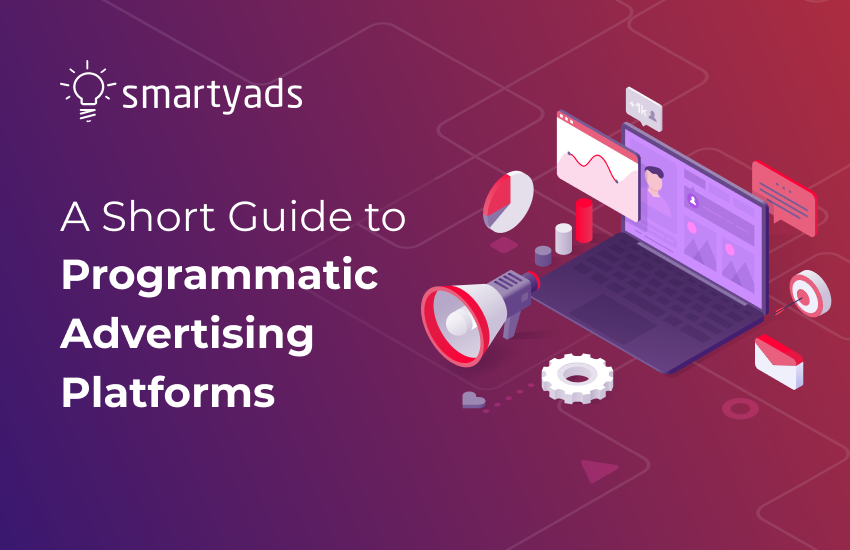Programmatic advertising platforms are booming. Some programmatic ad platforms compete by delivering real-time bidding RTB and direct (non-RTB) programmatic buying and selling, dynamic creative optimization, header bidding, unique digital ad formats, and first and third-party data integration to enhance audience targeting. The other compete through ad inventory quality, brand safety, and transparent ad tech practices.
There are so many details that you should remember to differentiate the best programmatic advertising platforms and their functions. Advertisers and publishers seek scalable and flexible innovation to buy and sell ad space.
That's why we are reviewing the best programmatic advertising platforms and custom solutions to elevate your programmatic marketing to the next level.
Programmatic advertising platform: functions and role in the ad ecosystem
What is programmatic advertising platform? Programmatic advertising platforms are designed to automate the process of media buying or media selling. Each of these platforms falls within the programmatic ecosystem.
- Demand-side platform DSP — Programmatic advertising platform created for advertisers. They automate media buying, finding the right ad space and the right customer. They run programmatic ads, optimization, and analysis.
- Supply-side platform SSP — Programmatic advertising platform created for publishers. Supply-side platforms automate the selling of programmatic ad inventory, ad space-filling, adjustment, and results analysis.
- Ad exchange is also an automated technology that works as an open marketplace (like supply-side platforms and demand-side platforms at the same time). Both supply and demand partners can join an ad exchange because it has functionalities for selling and buying media.
- Data management platform DMP facilitates audience targeting by gathering first and third-party audience data (non-personal data). The data management platform organizes audience segments and transmits relevant data to DSP.
The picture below shows how these programmatic advertising platforms interact (demand-side platform, supply-side platform, ad exchange).
Advertisers bid in real-time bidding auction thanks to DSPs, then the highest bid wins, and ad placement gets filled (ad impression gets served).
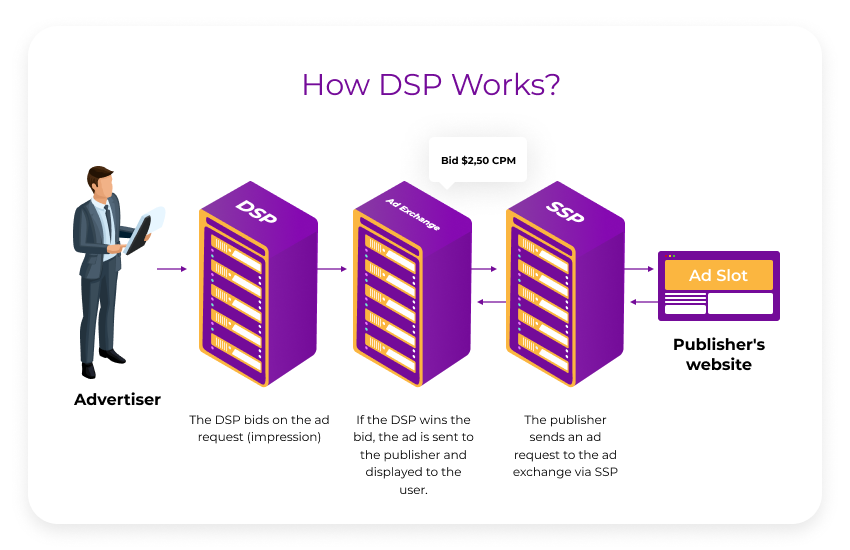
DMP meaning. If the advertiser has additional requirements on targeting (and needs more options than DSP provides), they find data providers and integrate a third parties data management platform DMP with their DSP.
Check how advertisers address their target audience during the programmatic advertising process. More about programmatic ad examples read in our previous article.
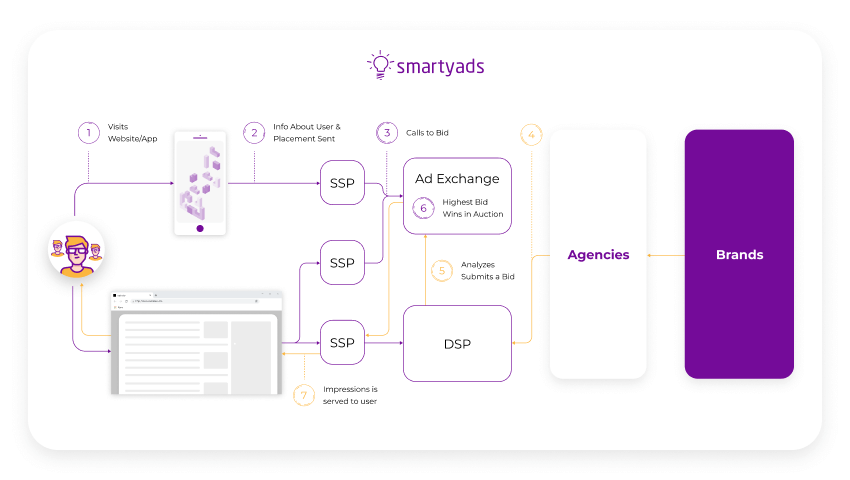
RTB and programmatic advertising, aren't they the same thing?
Not really; it's important to stop confusing programmatic with real-time bidding. Even though the programmatic platforms are based on real-time bidding, you can buy and sell ad inventory programmatically without participating in real-time bidding auctions.
Also, advertisers can participate in more advantageous auctions called header bidding.
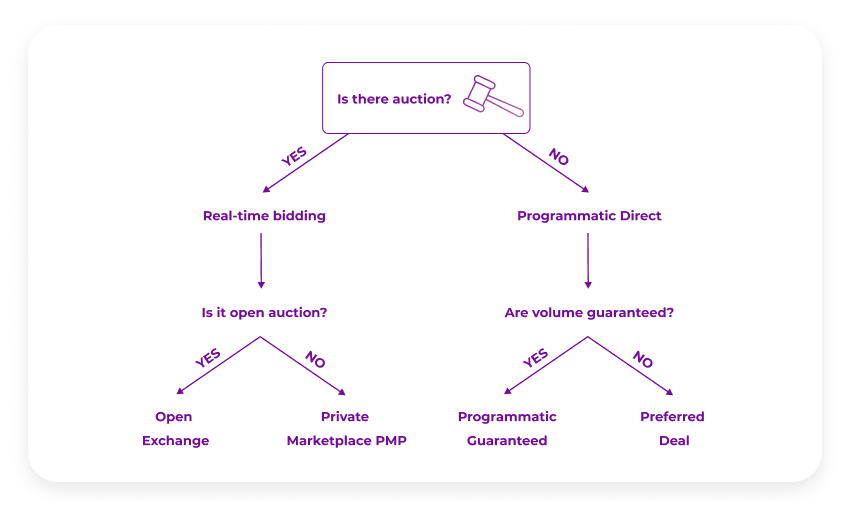
What are two common types of programmatic deals?
- RTB programmatic is based on real-time bidding RTB auction.
- Programmatic direct advertising is based on direct trading between publisher and advertiser (there's no auction).
What is the difference? Sometimes advertisers have established collaboration with certain publishers; they trust and prefer to work with them.
They also want to buy ad impressions straight from this publisher in bulk, so they don't need real-time auctions. That's why they choose direct deals.
In this case, programmatic platforms are still very useful — the advertiser knows who they buy ad impressions from and can still target their audience according to the selected criteria.
Meanwhile, real-time bidding RTB auctions effectively fight the problem of unsold advertising inventory. Many programmatic advertising platforms, including SmartyAds DSP, provide both types of deals.
CPC or CPM — what to choose on a programmatic advertising platform?
CPC is used more often for performance campaigns in programmatic advertising. In this case, advertisers pay only for clicks, no matter how impressions were shown to the users during their programmatic display advertising campaigns.
The cost per click on programmatic ad platforms with the CPM model is cheaper than CPC. At the same time, with CPC, advertisers know beforehand how many clicks they obtain.
Let's review the best programmatic advertising platforms starting with SSPs.
Top SSPs in 2025
Two most popular programmatic ad platforms in the SSP niche for selling ad inventory:
- SmartyAds;
- Xandr.
Supply-side platform comparison
| Supply-side platform | Ad inventory supported | Special programmatic ad capabilities |
|---|---|---|
| SmartyAds | Display, banner, native, text, video, mobile web, mobile in-app | Header bidding, PMP, inventory management, floor price, etc. |
| Xandr | All channels and formats — from display to Connected TV (CTV) and native | Data-driven yield optimization, yield analytics, and more |
Top ad exchanges in 2025
An ad exchange is a good programmatic advertising option for advertisers and publishers. Publishers and advertisers can normally use multiple ad networks and ad exchanges (ad tech partners).
Here's the list of the best programmatic advertising platforms in this niche:
- SmartyAds;
- Google Ad Manager.
Ad networks have a variety of functions, from dynamic creative optimization to audience targeting and header bidding.
One peculiar feature of Google Ad Manager is its ability to provide advanced targeting options for advertising campaigns. Advertisers on ad exchanges like Google Ad Manager can target their ads based on various criteria, including the user's location.
Meanwhile, SmartyAds ad exchange can offer a full-stack programmatic infrastructure and a variety of formats.
Comparison of ad exchanges
| Ad exchange | Ad formats | Channels | Countries | Special digital advertising capabilities |
|---|---|---|---|---|
| SmartyAds | Video, native, display, mobile, CTV | Omnichannel | Global reach | Brand safety, an abundance of programmatic ad partners, high ROI from serving programmatic ads |
| Google Ad Manager | Banner, native, in-stream, interstitials, rewarded, app open ads | Omnichannel | Global reach | Granular insights, Audience Solutions, data transfer reporting, open bidding, publisher-provided identifiers in the ad network |
Now, let's see the best programmatic advertising platforms in the DSP niche (list of 10 best DSPs).
Top DSPs in 2025
There is a bunch of leading programmatic platforms (top DSPs) in 2025. We've shortlisted top DSPs to give you pointers regarding the best programmatic advertising services for running programmatic ads:
- SmartyAds;
- Adform;
- DV 360 (Google);
- The Trade Desk;
- Xandr;
- Adobe Advertising Cloud;
- BidTheatre;
- MediaMath.

Peculiarities for serving programmatic ads on these platforms
So, the best programmatic advertising platforms on the DSP side have the following strongest sides:
 On SmartyAds DSP advertisers can run omnichannel ad campaigns. The platform supports various ad formats advertisers can use to effectively engage existing customers and address new ones: display, native, video, CTV, in-app, audio, DOOH, and more. Ad quality and brand safety are guaranteed by traffic safety providers SmartyAds collaborates with (like Pixalate). Advertisers can address the right target audience by choosing a variety of targeting options.
On SmartyAds DSP advertisers can run omnichannel ad campaigns. The platform supports various ad formats advertisers can use to effectively engage existing customers and address new ones: display, native, video, CTV, in-app, audio, DOOH, and more. Ad quality and brand safety are guaranteed by traffic safety providers SmartyAds collaborates with (like Pixalate). Advertisers can address the right target audience by choosing a variety of targeting options.
 The Trade Desk additionally offers a data marketplace; thanks to it, advertisers are reaching the audience data from the best data providers. Programmatic ad platforms like The Trade Desk apply artificial intelligence and machine learning algorithms to optimize ad campaigns in real time. Algorithms analyze data on user behavior, such as browsing history and search queries, to let the advertiser target audiences more precisely.
The Trade Desk additionally offers a data marketplace; thanks to it, advertisers are reaching the audience data from the best data providers. Programmatic ad platforms like The Trade Desk apply artificial intelligence and machine learning algorithms to optimize ad campaigns in real time. Algorithms analyze data on user behavior, such as browsing history and search queries, to let the advertiser target audiences more precisely.
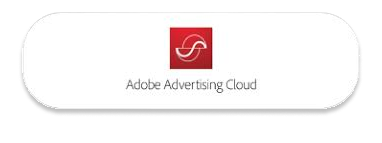 Adobe Advertising Cloud is an ad platform that helps advertisers to buy targeted ad space and serve programmatic ads thanks to smart optimizing algorithms. Adobe Advertising Cloud specializes in connected TV, video, display, native, and audio formats. It also has A/B testing and high-quality ad templates.
Adobe Advertising Cloud is an ad platform that helps advertisers to buy targeted ad space and serve programmatic ads thanks to smart optimizing algorithms. Adobe Advertising Cloud specializes in connected TV, video, display, native, and audio formats. It also has A/B testing and high-quality ad templates.
 Adform DSP uses data from a variety of sources, such as browsing history, search queries, and social media activity, to create highly targeted campaigns. It has ad creation tools and everything that covers the entire advertising process, from planning to reporting.
Adform DSP uses data from a variety of sources, such as browsing history, search queries, and social media activity, to create highly targeted campaigns. It has ad creation tools and everything that covers the entire advertising process, from planning to reporting.
 DV360 also belongs to the best programmatic advertising platforms because it can integrate with other Google products, such as Google Analytics, Google Ads, and YouTube. This integration allows advertisers to leverage data from these products to create more targeted and effective campaigns. This creates a perfect data marketplace available for advertising purposes.
DV360 also belongs to the best programmatic advertising platforms because it can integrate with other Google products, such as Google Analytics, Google Ads, and YouTube. This integration allows advertisers to leverage data from these products to create more targeted and effective campaigns. This creates a perfect data marketplace available for advertising purposes.
 One peculiarity of Xandr is its focus on using data to drive programmatic advertising campaigns (first-party and third-party data). Xandr also offers various formats, including display, video, and native advertising. It has advanced targeting options, including demographics, interests, behaviors, and geolocation.
One peculiarity of Xandr is its focus on using data to drive programmatic advertising campaigns (first-party and third-party data). Xandr also offers various formats, including display, video, and native advertising. It has advanced targeting options, including demographics, interests, behaviors, and geolocation.
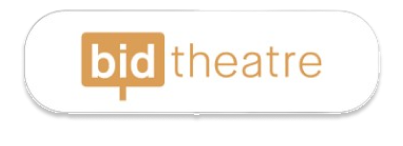 With BidTheatre, advertisers also can run cross-channel programmatic campaigns while focusing on everything — from ad creation and audience targeting to bidding and reporting. BidTheatre offers access to various ad formats, including display, video, and native advertising.
With BidTheatre, advertisers also can run cross-channel programmatic campaigns while focusing on everything — from ad creation and audience targeting to bidding and reporting. BidTheatre offers access to various ad formats, including display, video, and native advertising.
 MediaMath's platform provides real-time reporting and insights into ad performance, audience behavior, and conversion metrics, allowing advertisers to optimize their campaigns and improve their ROI. Data sources include first-party and third-party data pools. MediaMath also offers a range of programmatic ads, including display, video, and native ads.
MediaMath's platform provides real-time reporting and insights into ad performance, audience behavior, and conversion metrics, allowing advertisers to optimize their campaigns and improve their ROI. Data sources include first-party and third-party data pools. MediaMath also offers a range of programmatic ads, including display, video, and native ads.
Comparison of DSPs
| DSP | Formats | Targeting options | Brand safety tools | Special Capabilities |
|---|---|---|---|---|
| SmartyAds | Video, native, display, mobile, CTV, DOOH, audio | Geo, age range, IP, language, dayparting, etc. | Pixalate + in-house tools, IAB ads.txt | Omnichannel reach, CPM optimizer, creative auto resize, designing of creatives with Jam partner (on demand), and more |
| AdForm | Display, audio, video, CTV, DOOH, mobile and in-app | Behavioral, IAB categories, language, browser, domain, dayparting, etc. | AdMantX, Bearskin | Smart Deals, Private Marketplaces, Deal IDs, Programmatic Packages, First Party Data Segments |
| DV 360 (Google) | Panorama, Cuecard, and Blank Slate | First-party audiences, Third-party audiences, Google audiences, Combined audiences, Custom lists (Custom affinity and Custom intent) | IAB ads.txt, SafeFrame, HTTPS, etc. | Proprietary ecosystem and data segments |
| The Trade Desk | Display, video, audio, mobile, native, CTV | Cross-device targeting tools, apps, and app categories; location; device make and model; and operating system and more | HUMAN, Marketplace Quality team, Adx.txt, and other IAB standards | Data segments from partners, direct deals, Unified ID 2.0 |
| Xandr | Video, banner, audio, native, digital, CTV, and more | Operating systems, browsers, language, device model, or carrier, contextual, and more | White Ops | Xandr Graph, curated deal catalogs, first- and third-party data segments |
| Adobe Advertising Cloud | Display, video, audio, mobile apps, digital out of home (DOOH), TV, native, and social | Audience segment, device type, location, browser, manufacturer, and OS | Page screening and pre-bid filtering | AI and data integrations, on-demand inventory, and data segments |
| BidTheatre | Banner, video, and native ads, display and mobile, across desktop, mobile, and tablet devices | Weather, demographic, and other targeting options | Pre-bid filtering | Campaign KPI for CPC, CTR, CPM, and more, API, and real-time media spend optimization |
| MediaMath | Connected TV, display, mobile, video, audio, native, and DOOH | Audience segment, contextual, first-party data, site list, location, daypart, technology, video, and audio | Source Ecosystem with built-in pre-bid IVT protection | Omnichannel reach, data partners like IBM, Oracle, Double Verify, and Lotame, identity management with RampID, UID2.0, Merkle, ID5 |

What you can do with a demand-side platform
Sure, we discovered earlier that DSPs are designed for programmatic buying. This software automates the programmatic ad buying process and optimizes it so that programmatic campaigns can reach desired key performance indicators (excluding human negotiations and the tiresome manual process of ad placing).
But how to make programmatic advertising work for you?
In order to find out how to make it happen, we suggest you dive into the short function description so that you can understand what exactly you can do with DSP. A demand-side platform DSP arms you up with essential tools so that you can:
Find your perfect customer
This becomes possible thanks to the targeting features on the platform. Every impression your ad platform now bids on is evaluated from the standpoint of relevancy.
If the chosen display ad campaign criteria match the characteristics of the user, your offer will most likely fall within the interest pool of the user. Result — the platform will bid only on 'relevant' impressions so that you can address potential customers.
Fine-tune campaign look and feel
Yes, with a programmatic advertising platform like DSP, you can also define how your future programmatic ads will look (display ad campaign, video ads, native ads, banner, and CTV).
DSP allows advertisers to select different formats for various programmatic ad campaigns, choose from particular ad sizes, and decide what kind of publisher's inventory they will be shown at (filters, white and blacklists, etc.).
Also, you can select how many times one user can see your programmatic creative per day (to avoid irritation) — just apply frequency capping and decide how often your ad runs in front of one viewer.
Decide how to spend ad budgets
Advertisers who never used programmatic platforms often fear that automation may spend all their money, but this assumption is very far from true. There are more than enough advertising budget configurations in DSPs like SmartyAds.
With those leverages, you can limit daily and overall spending, adjust distribution evenly and precisely, instruct the system how it should spend your advertising money, adjust your programmatic creative, and so on.
Optimize and analyze
Optimization is essential to video ads, banner, CTV, or display ad campaign management. If you want your campaign to reach the best possible results, you must monitor it weekly and analyze and apply necessary changes.
In addition, on platforms like SmartyAds DSP, you can apply automatic optimization features that will increase the effectiveness of your digital campaigns over time.
With such platforms, you can also generate detailed data-driven reports across various metrics: impressions, conversions, and ad spend, to make changes to all your campaigns in real time.
Plus, you can choose among various formats and programmatic creative types: banner, video, native ads, CTV, and display advertising formats.
What platform qualities to look for in 2025?
Depending on the vendor, programmatic advertising platforms have unique functions and strong and weak sides.
It becomes especially challenging when advertisers choose DSP. This platform contains so many features that it is easy to get lost or prioritize a feature that is not really that important in the big picture.
So what really matters in programmatic marketing on DSP?
The programmatic platform should be self-learning and up-to-date
AI programmatic advertising software is based on artificial intelligence and self-learning machine algorithms, which means that with time, it must identify patterns and existing dependencies based on which certain actions will be taken.
For example, the click booster on SmartyAds demand-side platform is made to analyze each source's clickability depending on past experiences.
Then, it will automatically single out the sources with the best clickability level for the advertiser.
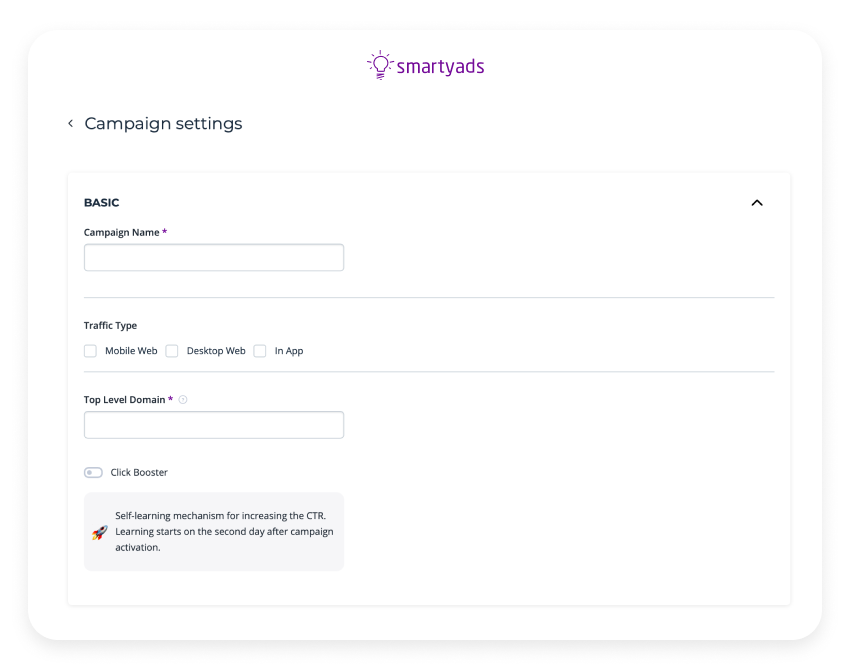
The right platform should be omnichannel and have lots of ad formats
This point goes without saying and many explanations — the more environments and ad formats your platform supports, the more opportunities you have as an advertiser.
For instance, SmartyAds demand-side platform is a programmatic advertising platform with 25K+ top global desktop, mobile web, and in-app partners who deliver traffic across digital channels & verticals, digital screens, and ad formats (for in-app, mobile web, desktop, and CTV). By the way, SmartyAds DSP is one of the top CTV platforms.
Still, it goes far beyond programmatic display advertising capabilities. Aside from programmatic display advertising formats, it serves interactive ad formats for in-app, desktop, mobile web, and CTV environments (e.g., rewarded video or playable).
Right DSP delivers campaign optimization
Again, here everything boils down to smart self-learning algorithms. In 2025 platforms don't only automate ad campaigns. They optimize them based on ad performance data derived from previous experiences (campaign data).
One example of such is the adaptive CPM function on SmartyAds DSP. It keeps the CPM at the optimal level by adapting the bid price.
This way, the bid price stays competitive enough to win impressions but not too high, preventing advertisers from overpaying.
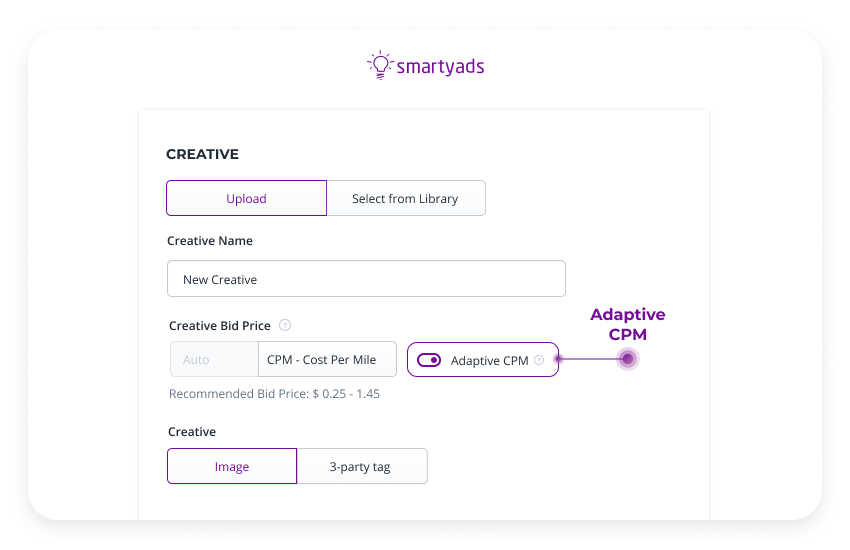
Additionally, we launched a new feature called creative autoresize that optimizes programmatic display ads and lets them fit more suitable ad spaces (adapts to the new screen size). This way, your programmatic creative has all changes to be more effective.
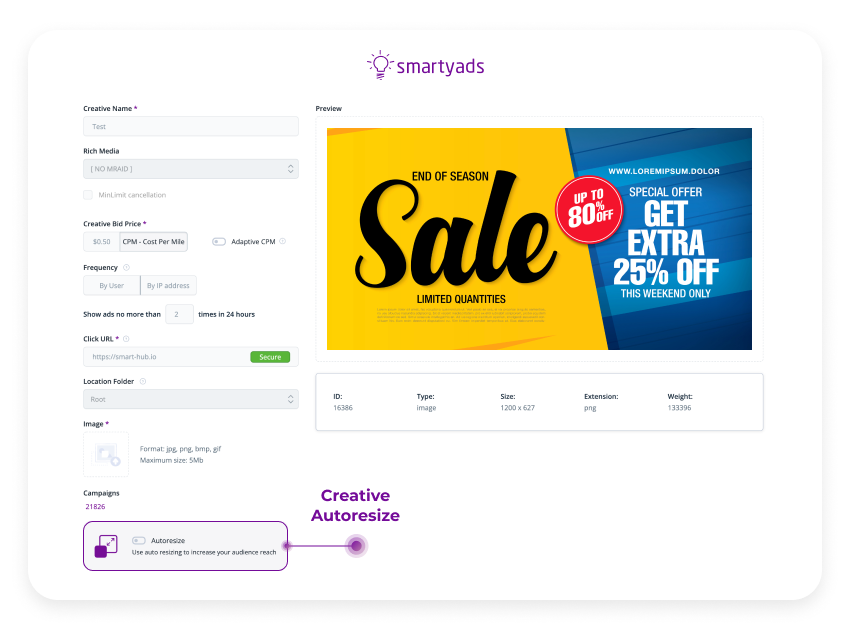
It should have great audience targeting
Targeting is exactly what helps you to place ads effectively. There are demographic audience targeting, targeting by interests, behavioral targeting, targeting according to social-economic status, geo-targeting, and more.
You can run multiple ad campaigns, each targeting a particular segment of users. The programmatic advertising platform you choose should offer the targeting options you use to find your audiences.
Many options exist to target audiences on SmartyAds DSP (geo, OS, divide type, age range, etc.).
Aside from this, you can configure frequency, dayparting, and filter lists and limit your daily ad spend to stick to your programmatic marketing strategy.
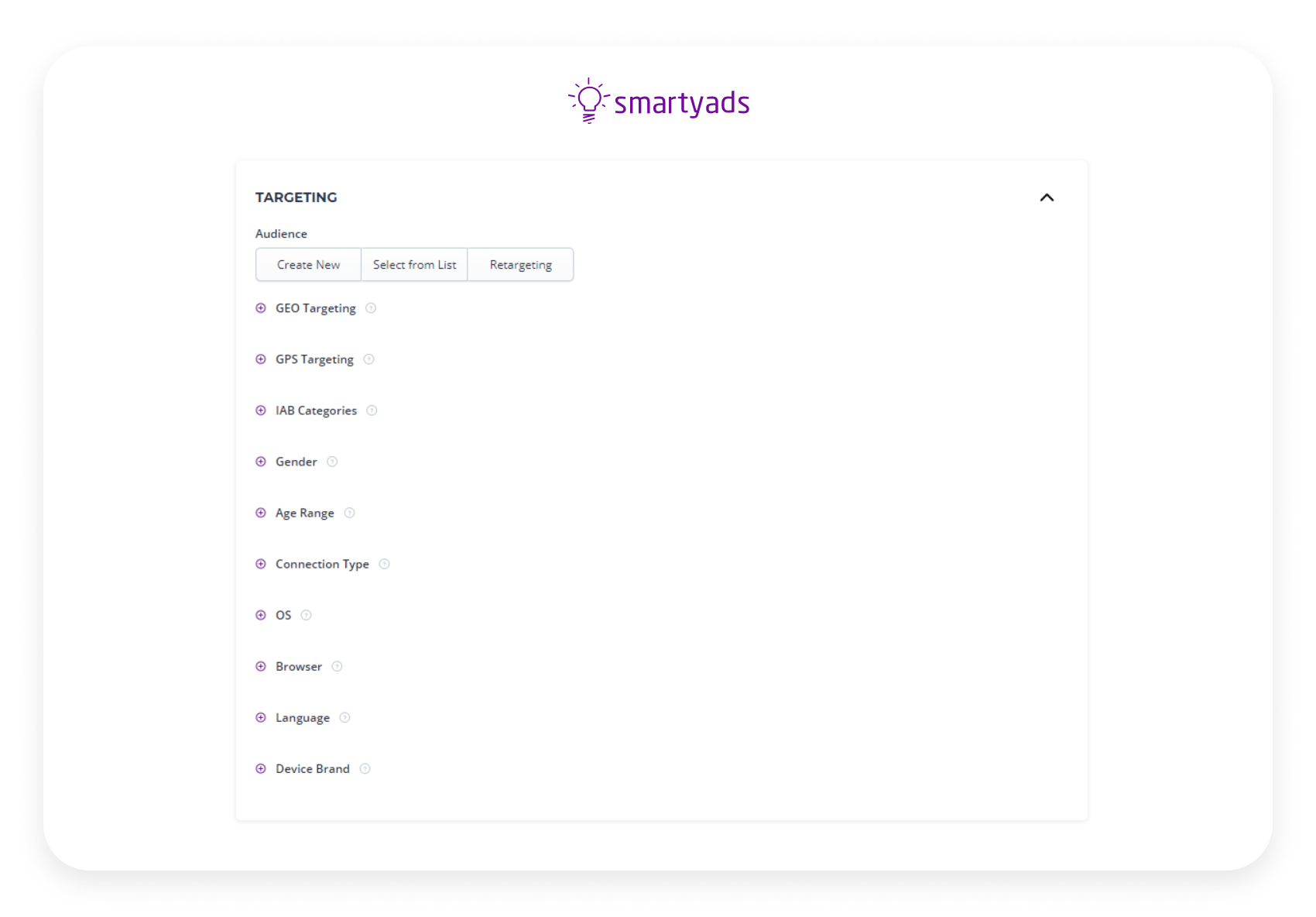
It should have a retargeting feature
Retargeting is an effective way of converting customers. Users visiting your site from a wide range of devices tend to bring in more profits in the long run than those using only one device.
Users who already know about your product and visit your site for the second time are also more likely to convert when exposed to your ad than those who see your brand/product for the first time.
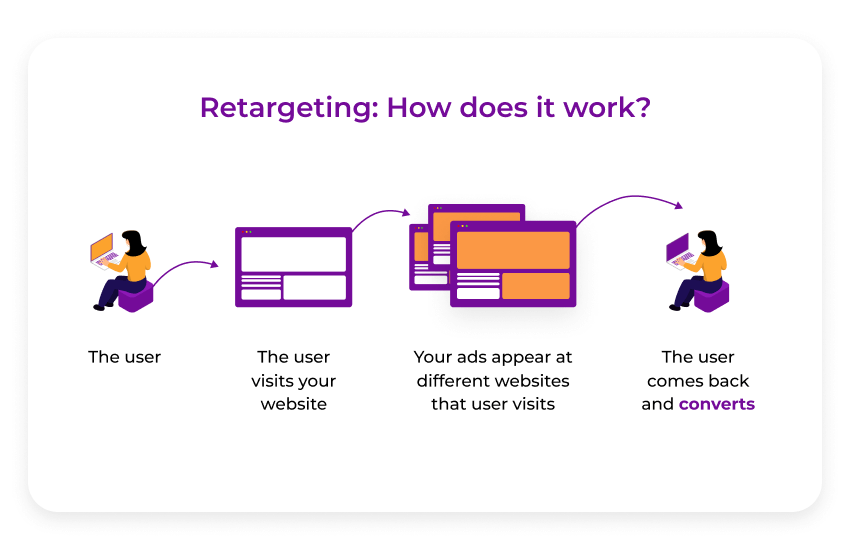
If you have access to retargeting technology (you can access it on SmartyAds DSP), you can remind your users about your offer by running retargeting campaigns across different devices (mobile web, in-app, desktop, and CTV).
It should be safe by design
Demand-side platforms and ad exchanges should provide good quality traffic with only human impressions.
Before choosing a suitable technology, ensure it corresponds to the best traffic safety standards.
For starters, verify if the platform implements the IAB safety standards like adx.txt or sellers.json and the rest of the established inventory and seller authorization measures.
In addition to this, you can ask your vendor if they collaborate with traffic safety providers, e.g., Pixalate, Geoedge, or Forensic.
It should provide timely customer support
Even though it seems natural, not all programmatic advertising platforms can show off great customer service.
Demand-side platforms, in most cases, are self-serve technologies. This means that advertiser has to have at least minimal competencies to operate them properly and buy ad space through a single unified interface.
However, recently, many companies changed their approach. Some of them prioritize customer service and consultations to help those new to programmatic advertising or who need extra support and guidance during campaign management.
It especially applies to custom self-serve solution, where all-encompassing support and customer care are the keys to reaching great campaign outcomes.
To wrap it up
The programmatic advertising process can be complicated for advertisers and publishers alike. Programmatic advertising platforms play a very important role in the organization of advertising processes today.
Our professionals strive to create an advanced, transparent, and predictable digital advertising ecosystem where every component complements the meaningful advertising experience. That's why we are always here to assist, educate, and guide you to desired outcomes!
Technology + customer care are at the heart of our DSP solution. Grow your campaigns at SmartyAds DSP.

